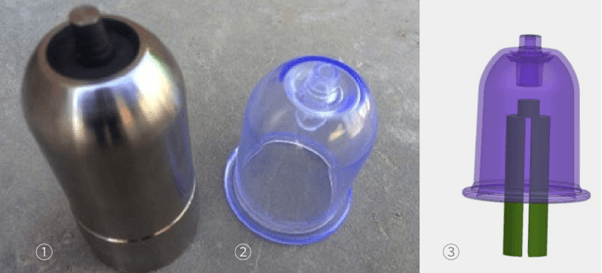3D Printer: EP-M260
Material: Mold Steel
In Short: Producing a highly optimized metal mold with E-plus 3D EP-M260 metal 3D printer with conformal cooling channels, in order to improve the quality of final cupping and injection efficiency.
Background: As one of the most popular production method, injection molding is responsible for the production of plastic and rubber parts. As the demands for quality increase the need for an optimized molds production is critical.
As a leading mass production manufacturing method, plastic injection molding is responsible for much of the plastics used by anyone every day. Traditional mold production are manufactures using CNC technique with its own set of limitations.
Additive 3D metal printing breaks those limitations and offers building optimized molds that are impossible to produce in traditional techniques and break the engineering limitations that were imposed in the past.
E-plus 3D was called to task in producing such mold that would answer to the client’s requirements. The client’s requirement are:

- Was an increased transparency of the cupping
- Reduce weight of the cupping
- Improve the efficiency of injection molding.
- Cupping metal molds produced via traditional CNC technique.
- Cupping produced by traditional injection molding has lower transparency and is made of PS materials
- Cooling channels of traditional molds

The conventionally produced cupping mold is only capable of producing vertical cooling channels and covers only limited mold area, causing inefficient cooling and low transparency of the final product.

Designing the mold while using 3D printing enables the designer to implement an advanced interwinding cooling channels that effectively cool the entire part, resulting in quicker mold injection process and better transparency due to effective total part cooling.
Using computer thermal simulation to reflect the improved cooling characteristics of the 3D printed cupping mold and its cooling channels, compared with the traditional older cupping mold, a reduction of 74oC is evident.

When cool the cuppings for 15 seconds, the final cuppings were 60℃ lower than those produced by traditional molds, with cooling efficiency increased by 60%. Meanwhile, it only takes 16.63s for the final cuppings to reach the ejection temperature. Compared to the traditional molds that require 22.97 seconds, the time was reduced by more than 6 seconds and the injection efficiency was increased by about 26%.
The 3D printed cupping mold had 26% shorter cooldown time, comparted with the traditional mold while effectively reducing cooling temperature by a factor of 60%. The temperature difference of conformal cooling channels between mold inlet and outlet through 3D printed metal molds is at most 5℃, which meets the design requirements of channels. The pressure is 0.3Mpa that meets the requirements of general mold temperature controllers without any stagnation, eddy current, backflow and so on.
To summarize, 3D printed metal molds with conformal cooling channels cannot only meet the requirements of injection molding process but only have more performance advantages over traditional molds, improving the injection efficiency as well as the quality of the final injection molding products.

